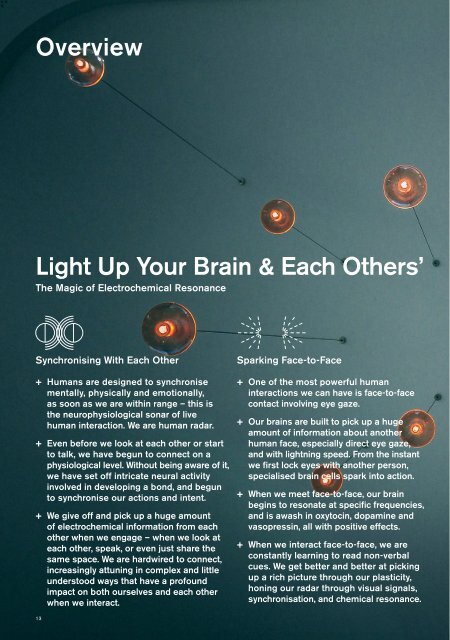THE ART AND SCIENCE OF LOOKING UP REPORT
You also want an ePaper? Increase the reach of your titles
YUMPU automatically turns print PDFs into web optimized ePapers that Google loves.
Overview<br />
Light Up Your Brain & Each Others’<br />
The Magic of Electrochemical Resonance<br />
Synchronising With Each Other<br />
Sparking Face-to-Face<br />
Lighting Up Each Other’s Brains<br />
Transferring Meaningful Messages<br />
+ Humans are designed to synchronise<br />
mentally, physically and emotionally,<br />
as soon as we are within range – this is<br />
the neurophysiological sonar of live<br />
human interaction. We are human radar.<br />
+ Even before we look at each other or start<br />
to talk, we have begun to connect on a<br />
physiological level. Without being aware of it,<br />
we have set off intricate neural activity<br />
involved in developing a bond, and begun<br />
to synchronise our actions and intent.<br />
+ We give off and pick up a huge amount<br />
of electrochemical information from each<br />
other when we engage – when we look at<br />
each other, speak, or even just share the<br />
same space. We are hardwired to connect,<br />
increasingly attuning in complex and little<br />
understood ways that have a profound<br />
impact on both ourselves and each other<br />
when we interact.<br />
13<br />
+ One of the most powerful human<br />
interactions we can have is face-to-face<br />
contact involving eye gaze.<br />
+ Our brains are built to pick up a huge<br />
amount of information about another<br />
human face, especially direct eye gaze,<br />
and with lightning speed. From the instant<br />
we first lock eyes with another person,<br />
specialised brain cells spark into action.<br />
+ When we meet face-to-face, our brain<br />
begins to resonate at specific frequencies,<br />
and is awash in oxytocin, dopamine and<br />
vasopressin, all with positive effects.<br />
+ When we interact face-to-face, we are<br />
constantly learning to read non-verbal<br />
cues. We get better and better at picking<br />
up a rich picture through our plasticity,<br />
honing our radar through visual signals,<br />
synchronisation, and chemical resonance.<br />
+ Meeting someone face-to-face turns<br />
on different parts of our brain than<br />
meeting virtually, creating a more<br />
personal connection that lasts longer<br />
and feels different.<br />
+ It is something that can’t be replicated<br />
through a screen.<br />
+ A different part of the brain lights<br />
up face-to-face and we can watch<br />
individuals wearing EEG caps<br />
neurally synchronising as they interact<br />
in person rather than over screens.<br />
+ Due to the chemical cocktail we create<br />
when we connect, not only do we light up<br />
each other’s brains but we each possess<br />
the power to rewire both our own brains<br />
and those of the people we interact with.<br />
It is like an in-built super power that we<br />
are hardly aware of, but we see and feel<br />
the results.<br />
+ When we actively engage, we synchronise<br />
the social and emotional networks in<br />
our brains. This state, which we call<br />
interpersonal neural synchronisation<br />
(INS) or neural coupling, allows us<br />
to transfer not just information, but<br />
meaning, delight, fear and aspiration.<br />
+ Neural coupling happens in positive<br />
face-to-face interactions when we’re<br />
paying attention and trying to engage<br />
the other person in what we’re seeing,<br />
thinking, feeling or imagining. Effective<br />
leaders, inspiring teachers, storytellers<br />
and engaging friends all demonstrate<br />
this capacity.<br />
+ The more we look up and out to engage,<br />
the more we read both the affect and<br />
effect we have on people, and the keener<br />
our radar becomes.<br />
14















